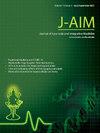Cystic swelling and inflammation of MCL of knee joint managed with homeopathy; a case study with literature review and diagnostic pitfalls
IF 1.9
Q3 INTEGRATIVE & COMPLEMENTARY MEDICINE
引用次数: 0
Abstract
Knee pain is the most frequently encountered complaint in clinical practice among diverse age groups. In India, osteoarthritis alone covers 25–35 % of all rheumatological conditions. That stands out as one of the common causes of misdiagnosis of all other soft tissue and ligamentous diseases of the knee joint. However, in light of common clinical manifestations like osteoarthritis, many cases go neglected and remains in the grey area of literature. Here we are reporting a case of a 65-year-old female patient who presented with knee pain, and difficulty walking, and she was previously diagnosed with osteoarthritis. However, ultrasonography (USG) revealed a cystic enlargement measuring 12.3 × 5.4mm distal to the medial-cutaneous ligament (MCL) with inflammation and local edema. Following a thorough case evaluation, the patient was prescribed Ruta graveolens 200CH, followed by Thuja occidentalis 200CH. The anti-inflammatory, anti-tumor, and anti-cancer properties of both these medicines have been thoroughly demonstrated via many scientific experiments. We believe the positive effect is due to their alkaloids, but we have not questioned how they maintain their qualities at such high dilutions. The Lysholm Knee Score and Tegner Activity Scale (TLSS) were used to quantify progressive improvement. Significant improvement was observed with the following remission of cystic edema and local irritation. The TLSS climbed to 78 at the end of treatment from 56 at the beginning. Despite being a rare clinical presentation of knee pain, this case report is valuable in homeopathy since it is the first attempt to analyze knee joint functionality using TLSS.
顺势疗法治疗膝关节MCL囊性肿胀和炎症一个案例研究与文献回顾和诊断缺陷
膝关节疼痛是临床实践中不同年龄组中最常见的主诉。在印度,仅骨关节炎就占所有风湿病的25 - 35%。这是所有其他膝关节软组织和韧带疾病误诊的常见原因之一。然而,鉴于骨关节炎等常见的临床表现,许多病例被忽视,停留在文献的灰色地带。这里我们报告一个65岁的女性患者,她表现为膝盖疼痛,行走困难,她之前被诊断为骨关节炎。然而,超声检查(USG)显示,在内侧皮肤韧带(MCL)远端有12.3 × 5.4mm的囊性增大,伴有炎症和局部水肿。经过全面的病例评估后,给患者开了Ruta graveolens 200CH,然后开了huja occidentalis 200CH。这两种药物的抗炎、抗肿瘤和抗癌特性已经通过许多科学实验得到了充分的证明。我们相信这种积极的效果是由于它们的生物碱,但我们没有质疑它们是如何在如此高的稀释度下保持其品质的。采用Lysholm膝关节评分和Tegner活动量表(TLSS)对进行性改善进行量化。随着囊性水肿和局部刺激的缓解,观察到明显的改善。治疗结束时,TLSS由治疗开始时的56分攀升至78分。尽管膝关节疼痛是一种罕见的临床表现,但本病例报告在顺势疗法中是有价值的,因为它是第一次尝试使用TLSS分析膝关节功能。
本文章由计算机程序翻译,如有差异,请以英文原文为准。
求助全文
约1分钟内获得全文
求助全文
来源期刊

Journal of Ayurveda and Integrative Medicine
INTEGRATIVE & COMPLEMENTARY MEDICINE-
CiteScore
4.70
自引率
12.50%
发文量
136
审稿时长
30 weeks
 求助内容:
求助内容: 应助结果提醒方式:
应助结果提醒方式:


